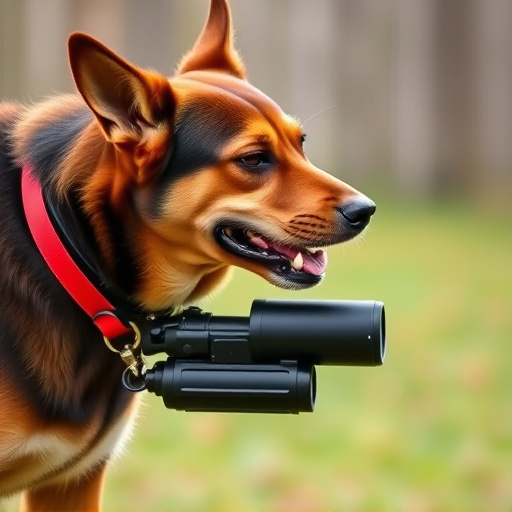Pepper spray designed for dog aggression offers a safe and effective solution for managing dangerous situations with aggressive dogs, targeting their eyes, nose, and respiratory system with capsaicin. The recommended safe spraying distance is 3-5 meters (10-16 feet) to avoid bystander risks, varying based on dog size, behavior, product range, wind conditions, and terrain. Always read product labels and follow safety guidelines, using pepper spray as a last resort after exhausting non-lethal methods. The effective safe distance is typically 2-3 meters (6-10 feet), with extreme caution required. Legal and ethical considerations regarding animal welfare include strict guidelines and training to prevent abuse or long-term health effects.
“Confronting aggressive dog behavior can be daunting, but understanding pepper spray as a potential solution is crucial. This article guides you through the intricacies of using pepper spray for dog aggression management. From deciphering its mechanism and identifying the optimal safe spraying distance—a critical factor in its effectiveness—to exploring safety precautions and legal implications, we demystify this tool. Learn how to navigate this complex issue responsibly, ensuring both canine and human safety while considering ethical boundaries, especially regarding the safe spraying distance for dogs.”
- Understanding Pepper Spray for Dog Aggression: What It Is and How It Works
- Determining the Safe Spraying Distance: Factors to Consider
- Effective Use and Safety Precautions When Dealing with Aggressive Dogs
- Legal Implications and Ethical Considerations for Pepper Spray on Dogs
Understanding Pepper Spray for Dog Aggression: What It Is and How It Works
Pepper spray, specifically designed for dog aggression, is a non-lethal tool that can be a game-changer in managing dangerous situations. It’s a safe and effective solution when dealing with aggressive dogs, offering a quick way to immobilize and deter them without causing severe harm. This type of spray works by targeting the dog’s eyes, nose, and respiratory system, temporarily disrupting their balance and sensory perception. The active ingredient, capsaicin, is derived from chili peppers, creating an intense burning sensation that prompts the dog to withdraw and run away.
The safe spraying distance for dogs is crucial, and it’s recommended to use pepper spray at a range of 3-5 meters (10-16 feet). At this distance, the spray can reach the dog without posing a direct risk to bystanders or users. It’s important to follow instructions carefully and ensure proper training before considering pepper spray as an option for aggressive dogs. This method is best used as a last resort when other non-lethal techniques have failed, providing a layer of protection in potentially dangerous encounters.
Determining the Safe Spraying Distance: Factors to Consider
When considering pepper spray as a deterrent for aggressive dogs, understanding the safe spraying distance is paramount. Several factors influence this critical aspect, ensuring both effectiveness and minimizing risks. The distance varies based on the dog’s size, behavior, and the specific product’s range. For instance, larger dogs may require a slightly longer safe distance due to their potential force and reach.
Additionally, the spray’s concentration, wind conditions, and terrain play key roles. Windy environments can affect the spray’s trajectory, while rough or uneven ground might disrupt even application. It’s crucial to read product labels thoroughly and familiarize yourself with safety guidelines before considering pepper spray as a solution for aggressive canine encounters.
Effective Use and Safety Precautions When Dealing with Aggressive Dogs
When dealing with aggressive dogs, it’s crucial to understand that pepper spray should only be used as a last resort and when other non-lethal methods have been exhausted. Effective use requires a clear understanding of the safe spraying distance for dogs, typically around 2-3 meters (6-10 feet), to ensure accuracy without causing unnecessary harm or stress. Aiming directly at the dog’s face or eyes can be effective in disorienting and temporarily incapacitating them, but it must be done with extreme caution to avoid injury to bystanders or the handler.
Safety precautions are paramount. Pepper spray is an irritant and can cause severe reactions, even in small concentrations. Always wear protective gear, including goggles and gloves, to minimize exposure. Ensure adequate ventilation in the area, as pepper spray can linger and affect breathing. Moreover, be prepared for the dog’s reaction; they may become more aggressive or panic, so maintain a safe distance and allow them space to retreat. Regular training and familiarization with the spray device are essential to ensure its effective and responsible use around dogs.
Legal Implications and Ethical Considerations for Pepper Spray on Dogs
The use of pepper spray on dogs, especially in aggressive or dangerous situations, raises significant legal and ethical questions. In many jurisdictions, the application of force against animals is regulated to ensure animal welfare and prevent unnecessary suffering. While some regions allow the use of pepper spray as a last resort for dog bite prevention or control, strict guidelines are in place regarding its deployment. One critical factor is the safe spraying distance for dogs, which requires careful consideration to minimize harm.
Ethical concerns revolve around the potential for abuse and the overall well-being of animals. Pepper spray can cause severe discomfort and even long-term effects on canine health if not used appropriately. Responsible use demands training and proficiency for handlers to ensure they employ this method only when necessary, following established protocols. It’s essential to explore alternative methods first and consider the context in which pepper spray might be deemed a suitable option, always prioritizing the dog’s safety and the public’s as well.
Pepper spray can be a useful tool in managing aggressive dog encounters, but it should be used with caution. Understanding the safe spraying distance and proper application techniques is key to ensuring both dog and handler safety. Always consider legal implications and ethical responsibilities when employing this method, as responsible usage requires a balanced approach between protection and well-being. By following safety precautions and staying informed about local regulations, individuals can effectively navigate challenging situations with aggressive dogs while minimizing potential harm.
